Last updated on 2025-11-11
Traveling all the way to Hamamatsu

“Uchida Aguri: Fluxes” viewing report
This page is a report on the exhibition “Uchida Aguri Han Fluxes” held at the Hamamatsu City Akino Fuku Museum of Art on June 15, 2024. It also includes a record of sightseeing around the area in the remaining time.
Although the exhibition has already ended, I hope this information will be of some use to you when you visit the Hamamatsu Akino Fuku Museum of Art.
Table of contents
Visit Report
Hamamatsu City Akino Fuku Museum of Art “Uchida Aguri: Fluxes”
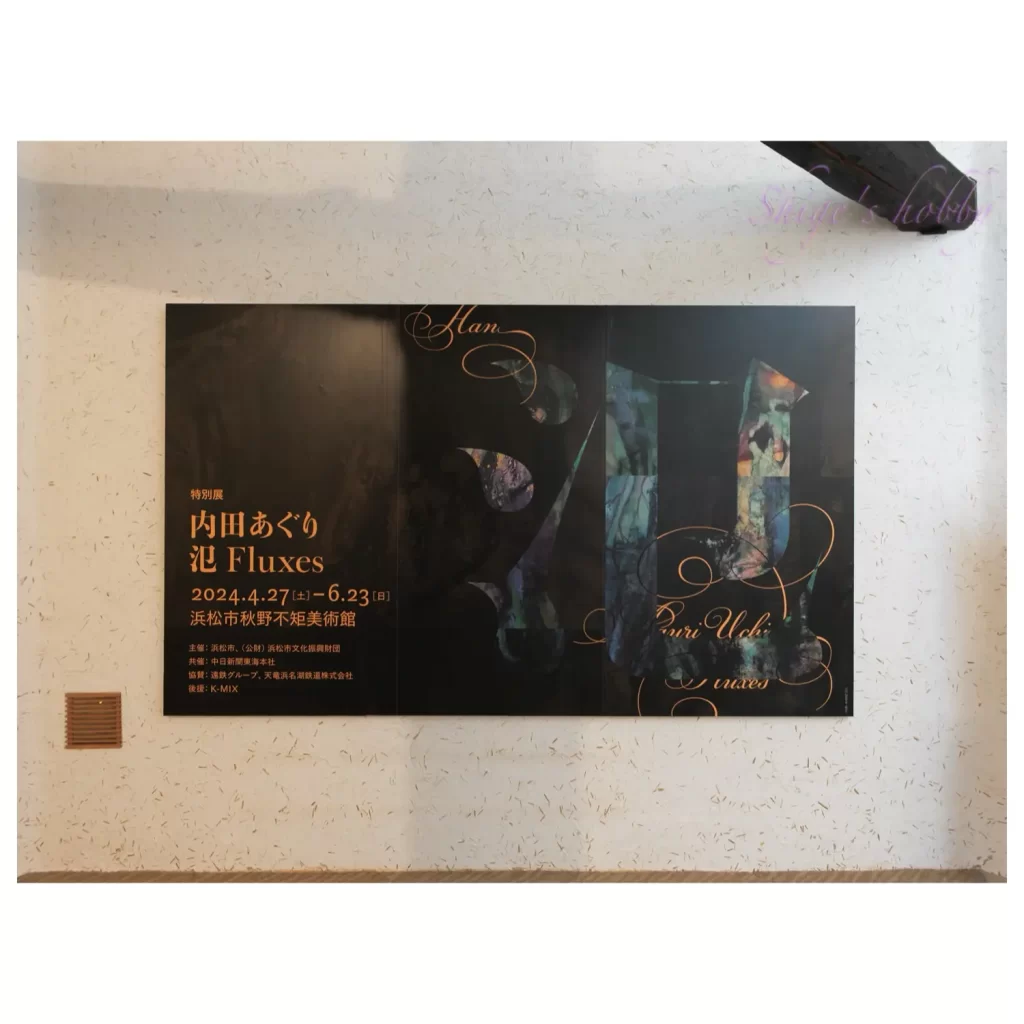
About Exhibition(Link to official page)
- Aguri Uchida – Fluxes
- Saturday, April 27th, 2024 – Sunday, June 23rd, 2024
- 9:30am – 5pm (entry until 4:30pm)
- Hamamatsu City Akino Fuku Museum of Art
- Adults 800 yen (Tenhama Line discount available)
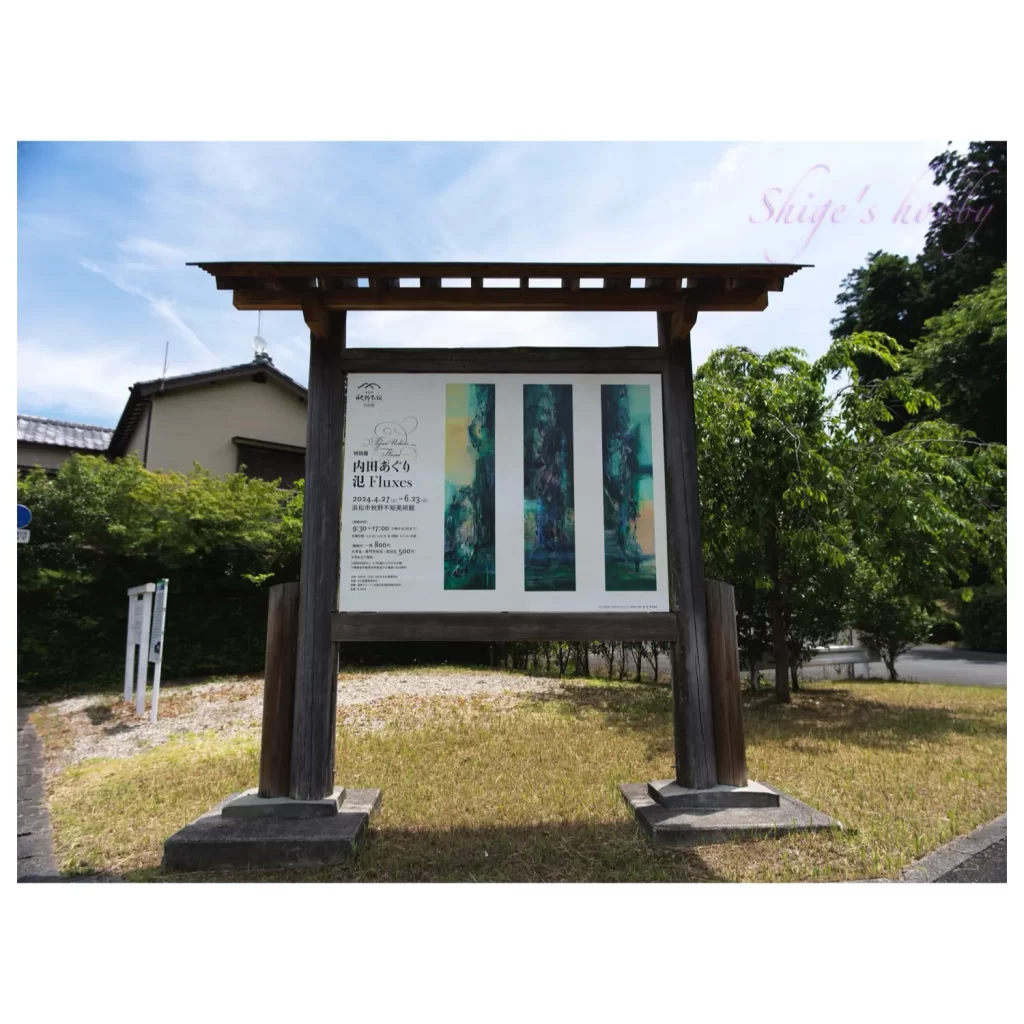
Exhibition Room 1
- At the Akino Fuku Museum of Art, you take off your shoes before entering the exhibition room. Photography is not permitted in this room.
- The current special exhibition, “Uchida Aguri Han Fluxes,” begins with an exhibition of Akino Fuku’s works and leads on to Uchida Aguri’s own works, focusing on the common theme of depicting people (living things).
- Among Akino Fuku’s drawings, there are several of cats, making him seem like a cat-loving painter.
Exhibition Room 2
- It was just time for the director to explain the works, so I enjoyed the exhibition while listening to his explanation.
- The largest work was displayed in a folded form because the wall between them was not high enough, and as a result, the flow of the work, which was a waterfall, was connected to a river and spread out.
- The director’s explanation helped me understand that Uchida did not just exhibit paintings, but created this exhibition as an installation that included the arrangement of the works, the construction of the supports, and the space, and I felt like I got a little closer to the intention of the work.
- The director told me that a drawing work was on display behind Uchida Aguri’s “Remnant Hill” in the first exhibition room.
- The protrusion in the center of the room (in front of the work in the photo below) is a power spot, and the inside of the protrusion is hollow, and it contains stones that the designers Terunobu Fujimori and Fuku Akino picked up from the Tenryu River. No one knows what it is except for the two of them, and I hope that the mystery will remain a mystery forever.
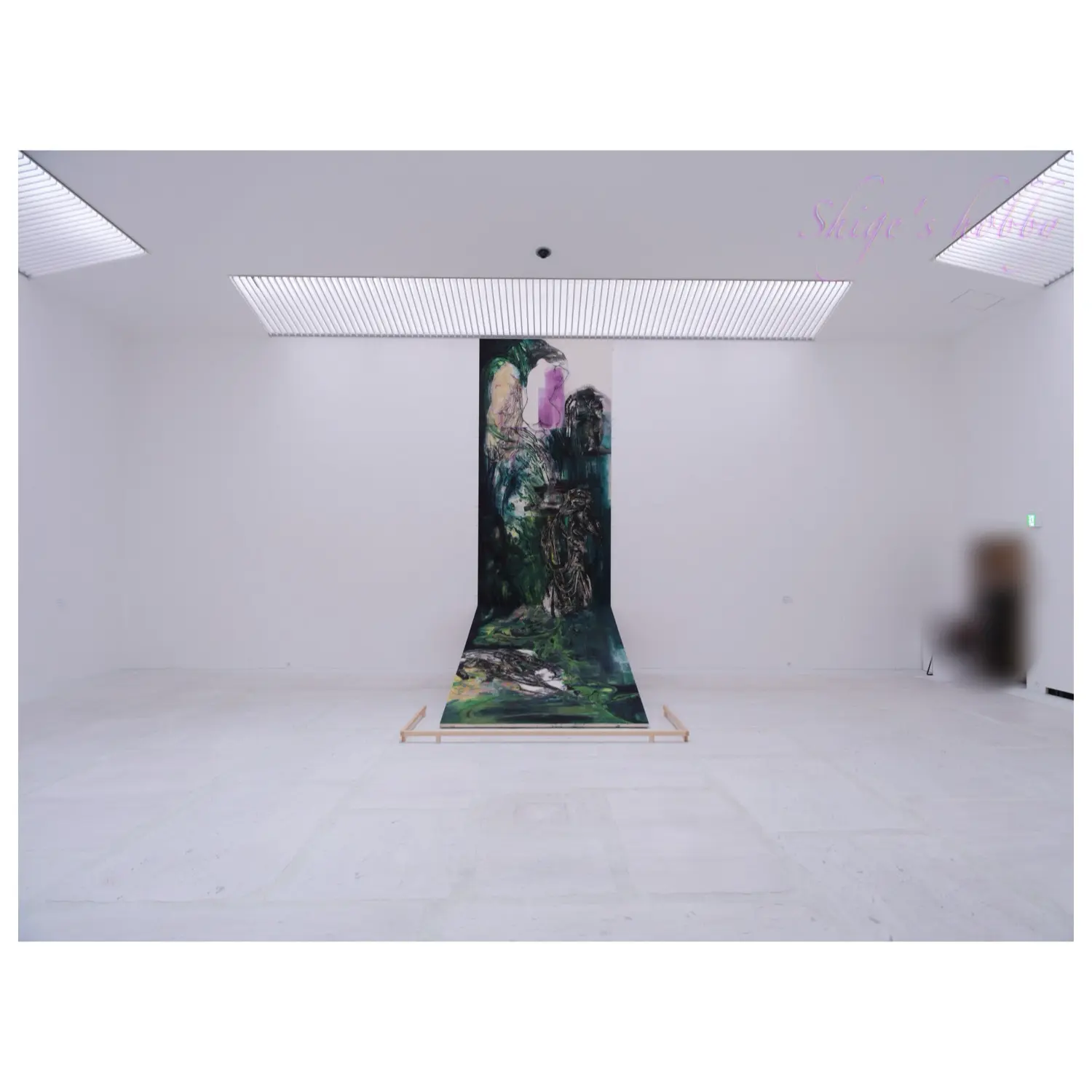
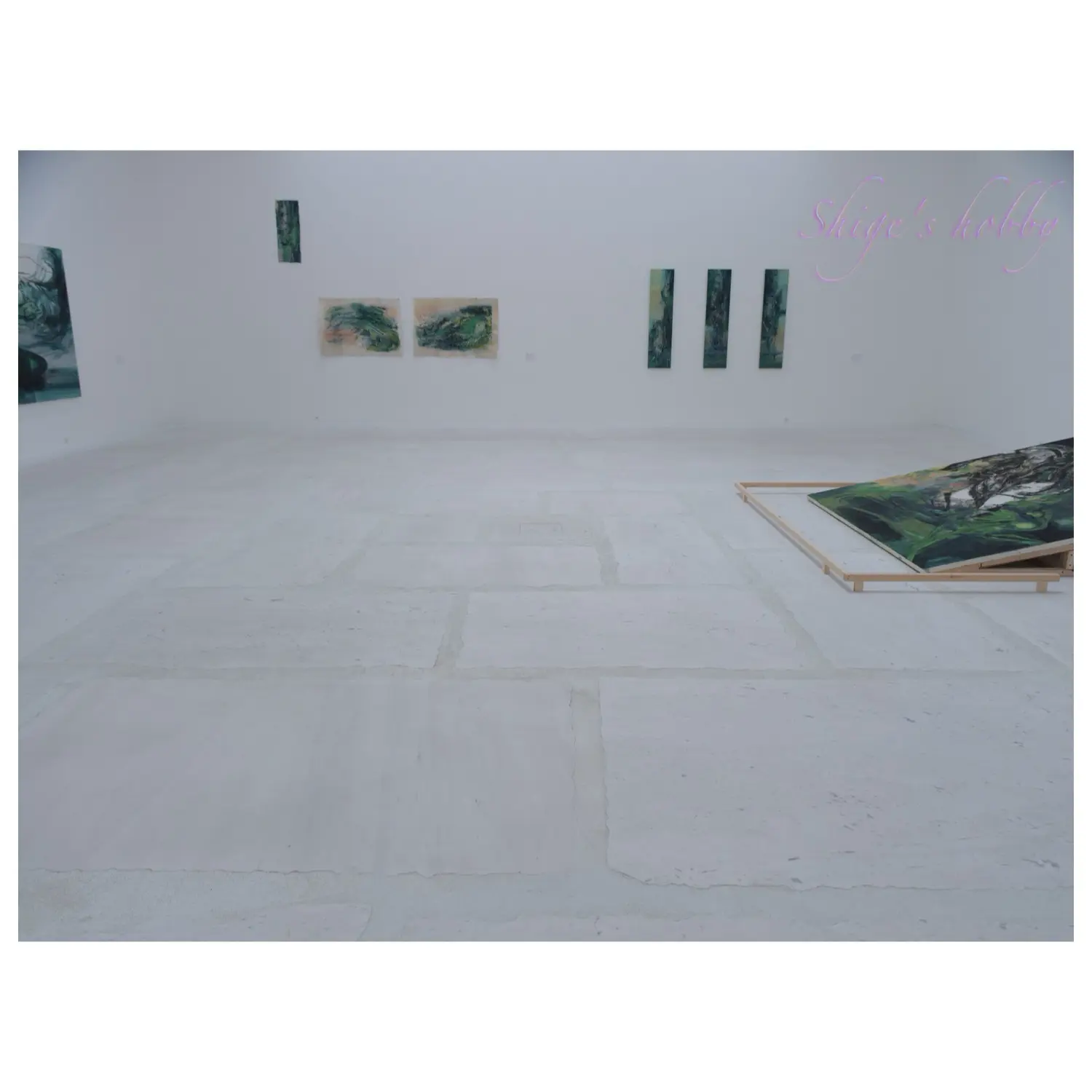
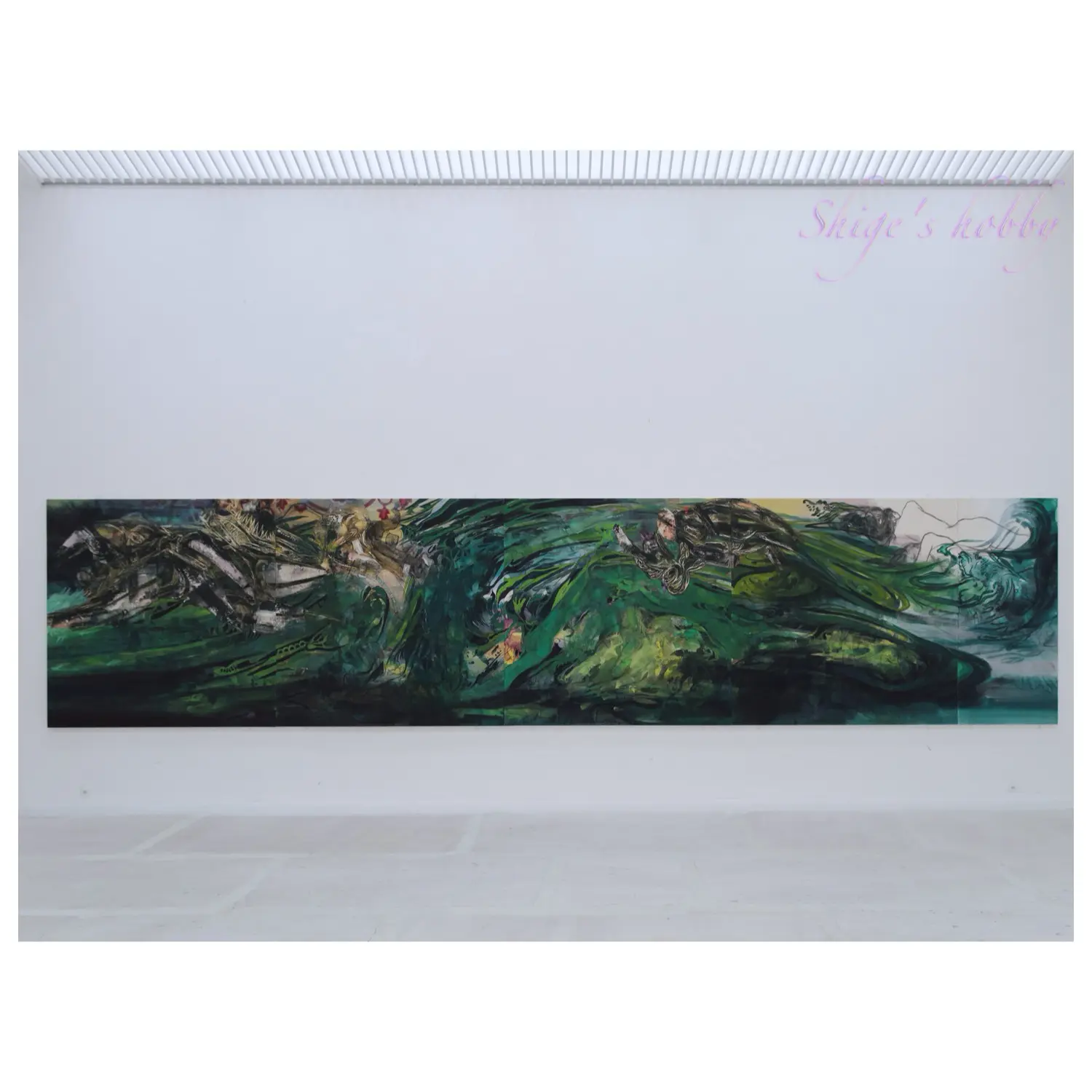
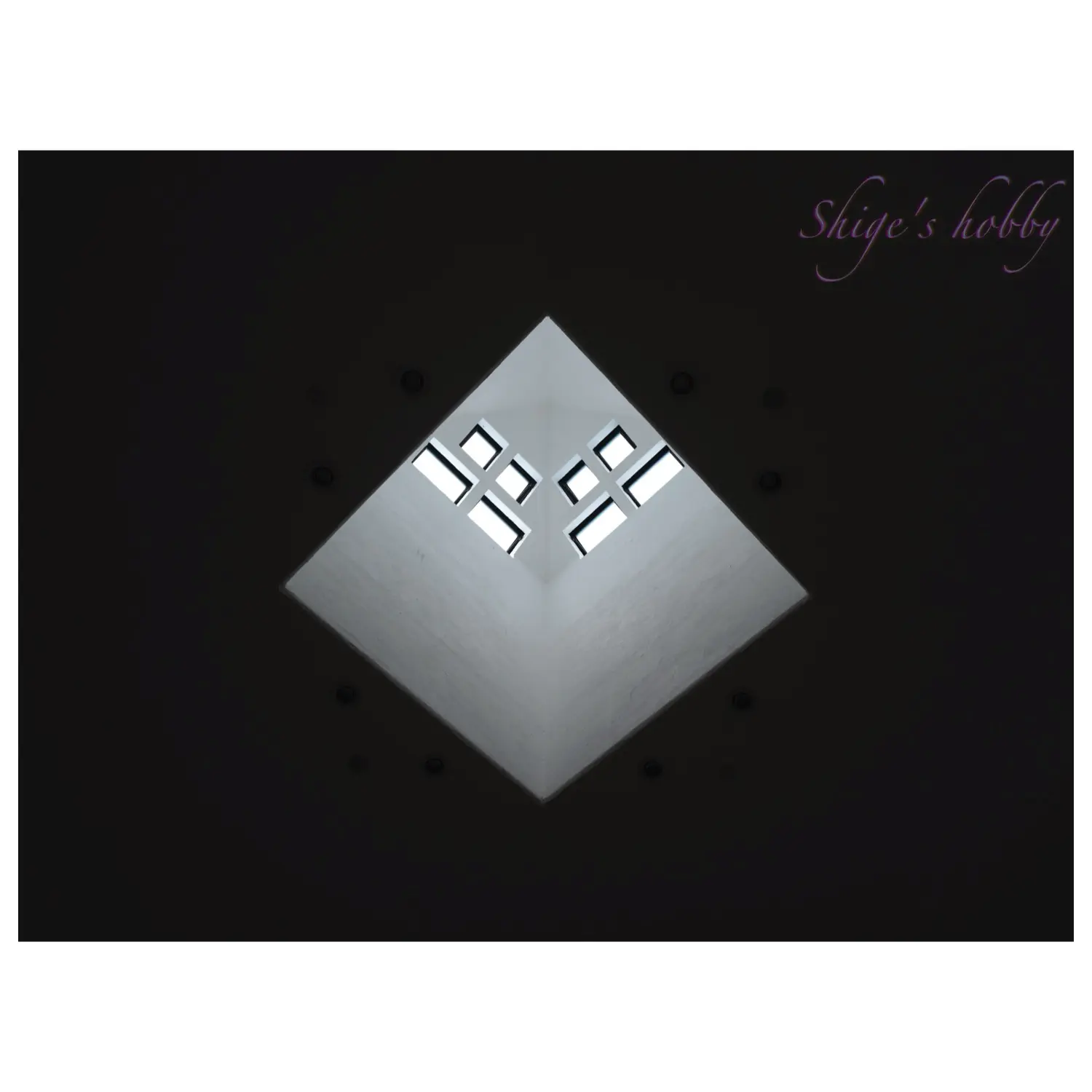
- The Romanov’s Sea, owned by the Fukushima Prefectural Museum of Art, was accompanied by a poem written by a student. It was a wonderful piece of writing that was written with a firm grasp of the artwork.
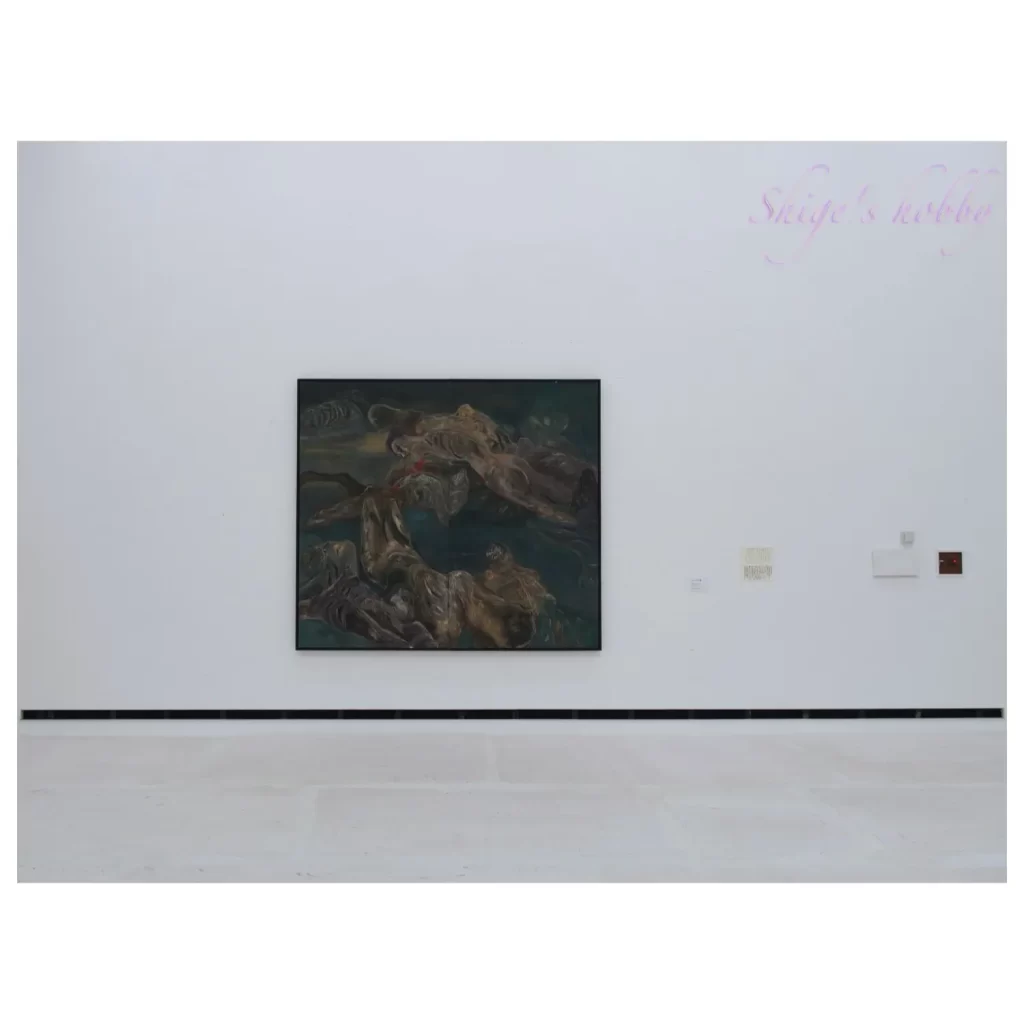
- As a privilege granted by the museum director, we were able to dim the lights in the second exhibition room, and the works looked much more subdued when viewed in natural light alone, with their rough impression being toned down.
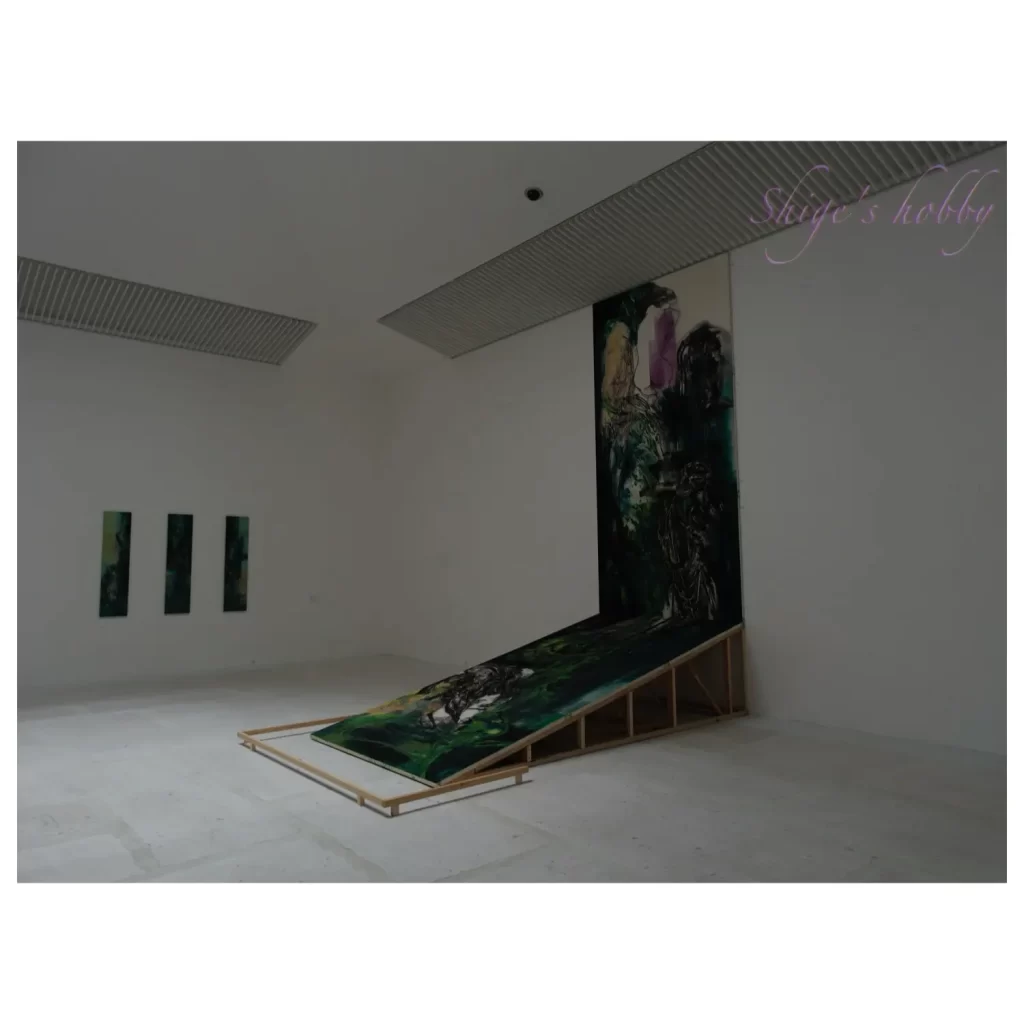
2F Gallery
- On display were works painted at a workshop on April 27th, 2024. The works had a youthful, relaxed appearance but also a sense of tension, which was refreshing, and although I don’t think this experience will be of direct use to the artist, I hope it will be of some use to him.
- There was also a model of the early exhibition concept for “Uchida Aguri: Han Fluxes,” and it was interesting to see the difference between this and the current exhibition.
- Photography is not permitted in this room.
Outdoors
- This museum was built on a cliff designed by Terunobu Fujimori. Opposite you can see the teahouse “Bohkuro”, also designed by Terunobu Fujimori, which was completed in 2018.
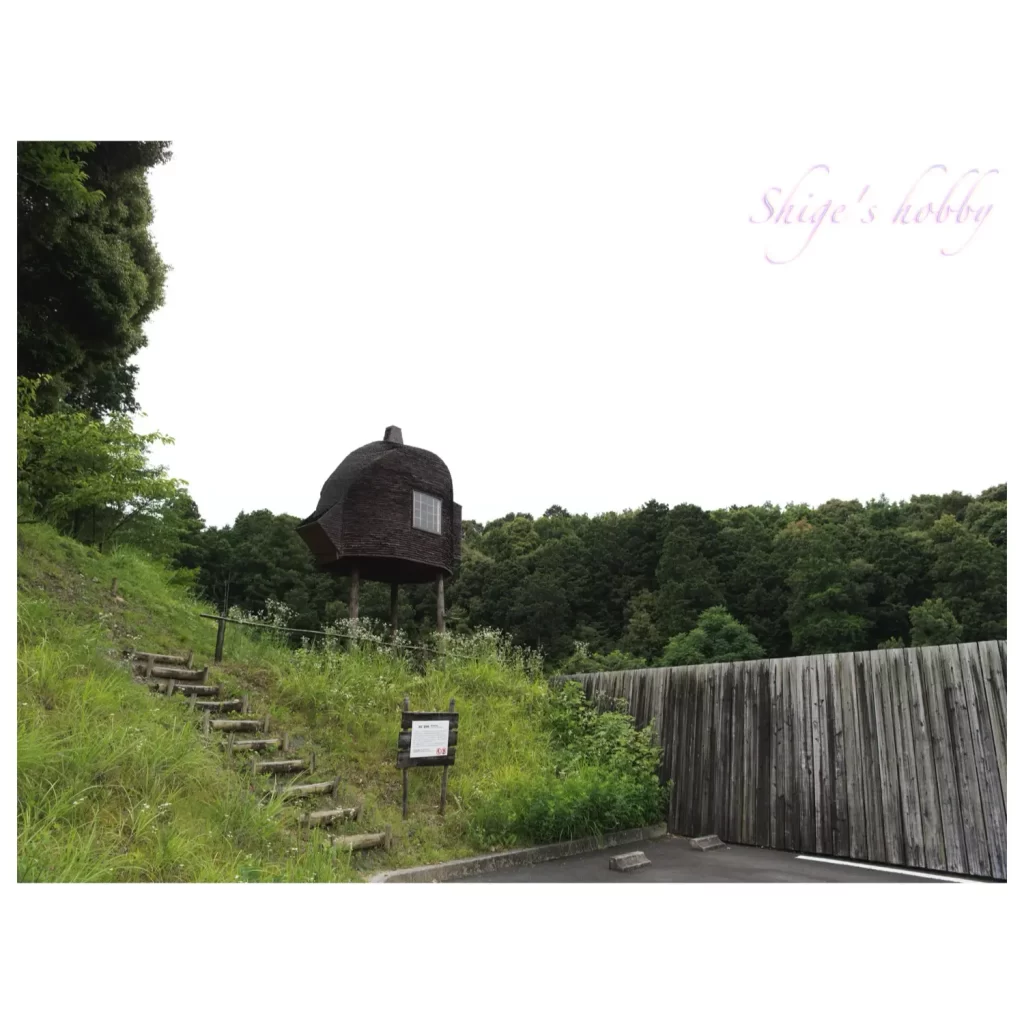
Tenryufutamata Station
- Tenryufutamata Station offers a tour of the depot. If you buy a ticket before the tour starts and wait in the waiting room, a guide will guide you around the depot. There was a demonstration of turning the depot, which was quite impressive. The museum has many nostalgic railway goods on display. This town is said to be the inspiration for Village 3 in the Evangelion 3.0+1.0 Thrice Upon a Time, so you can see Evangelion-themed trains and the Spear of Longinus.
- The guide was very interesting, and she told me all sorts of things, such as how the turning device is no longer used for turning, how the Tenhama Line became a third-sector company, how the tracks are currently inspected, how Doctor Tokai inspects conventional lines, not Doctor Yellow for the Shinkansen, how the water tower remains but is no longer functioning and it’s a shame that there are no steam locomotives, and the cats at the station come to work from the neighborhood.
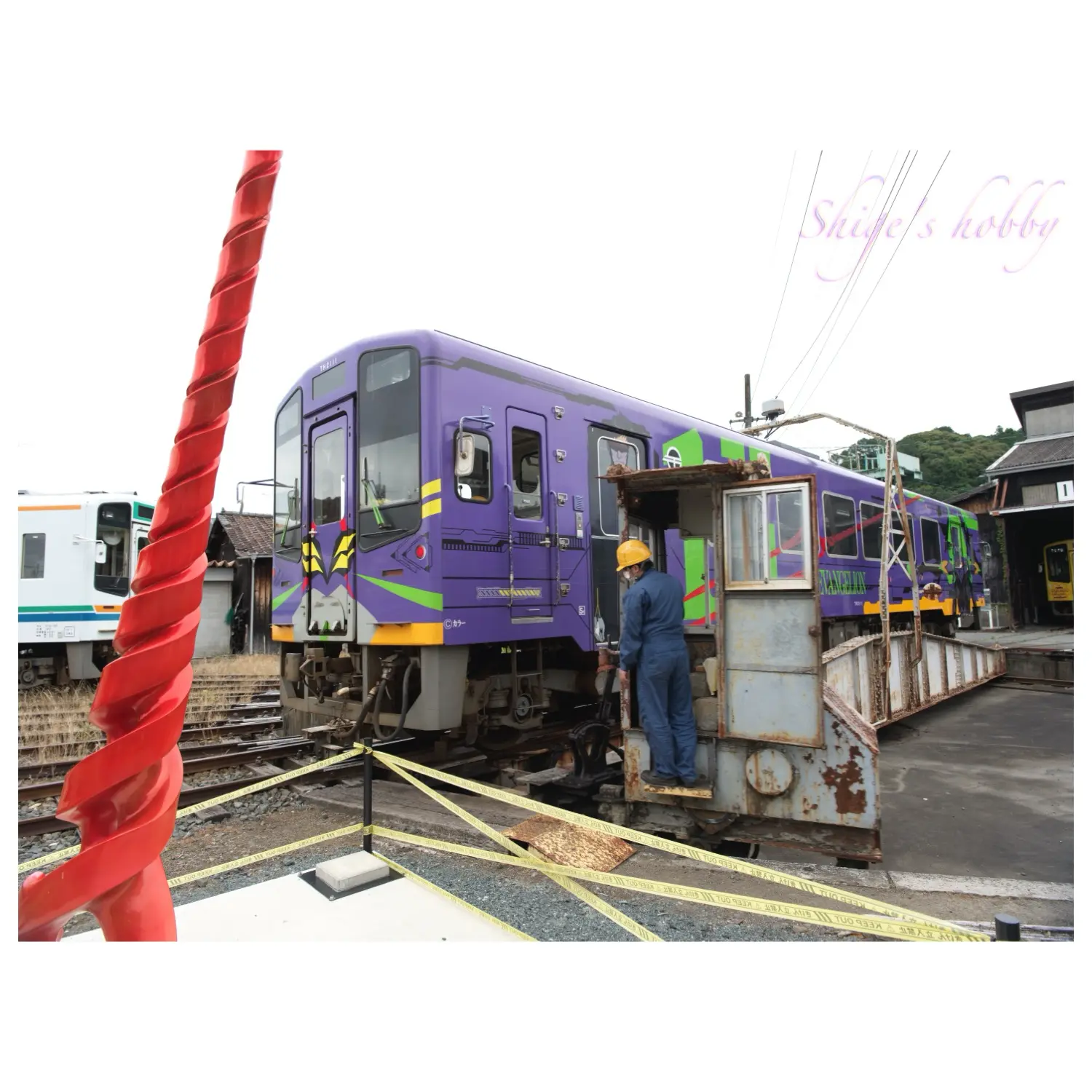
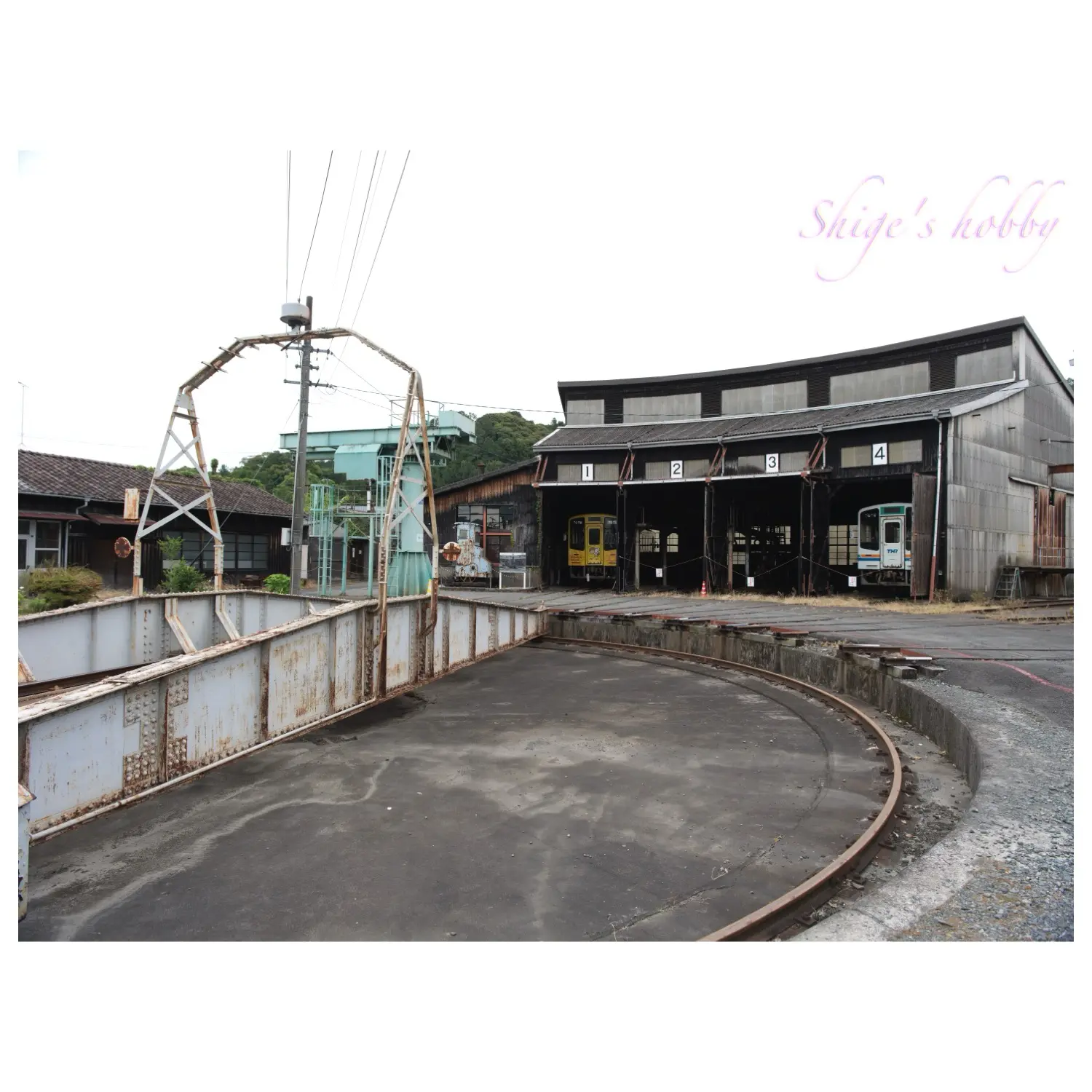
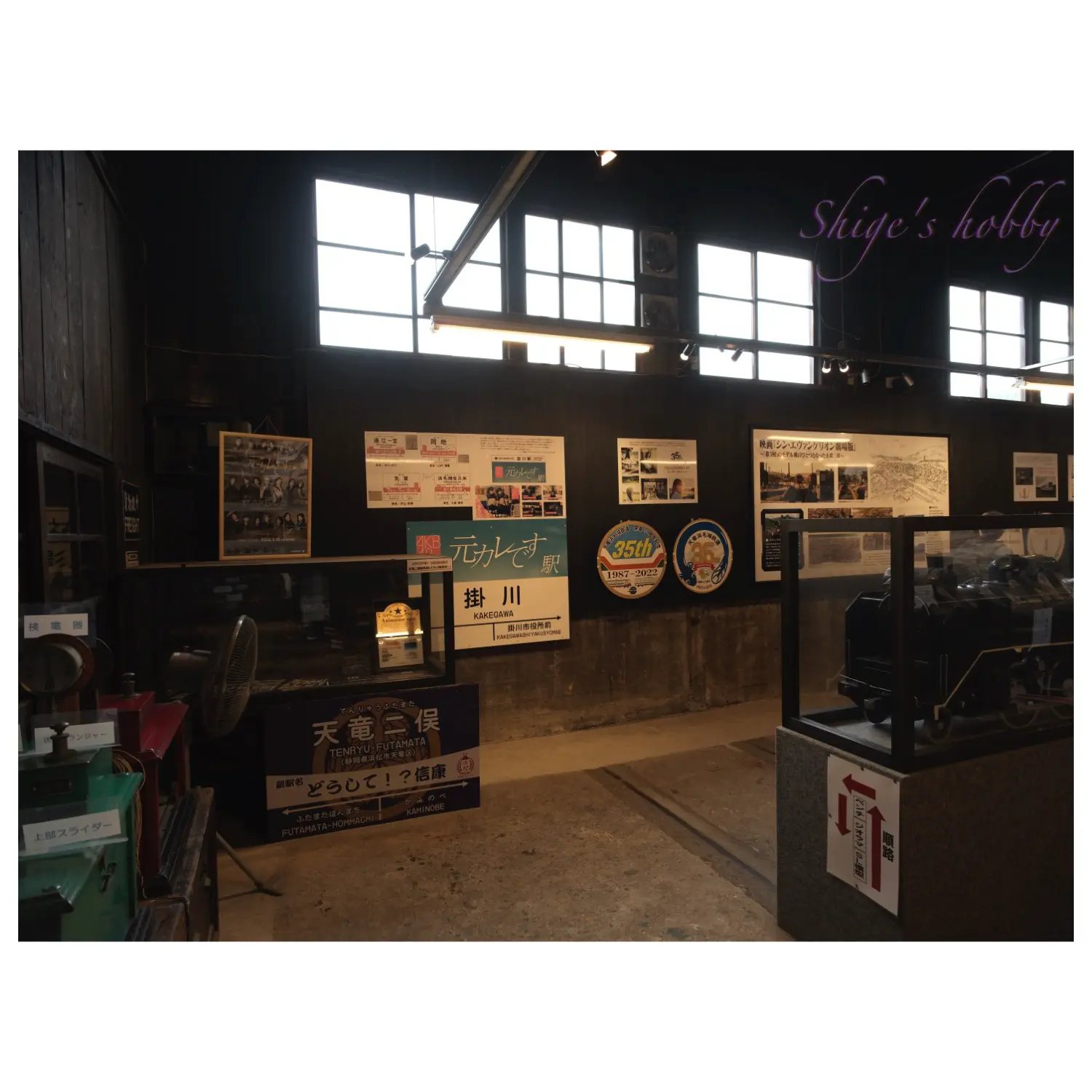
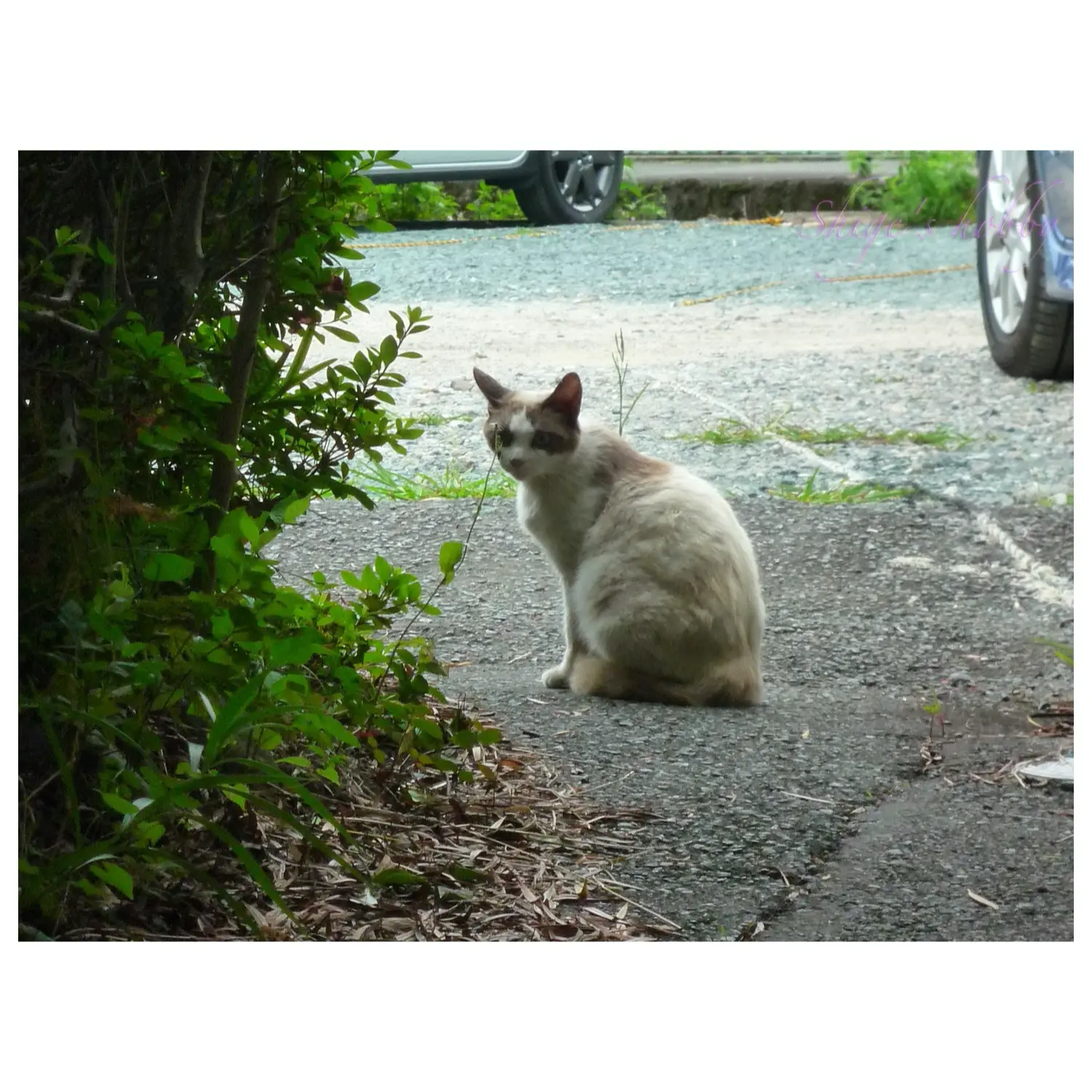
Stained Glass Museum
- It had been a while since I last visited here. I remembered that the stained glass exhibit was quite substantial, even though it was compact, when I had been there before, so I decided to return since I was in Kakegawa this time.
- The stained glass is tightly packed into the small museum, and the three-dimensional exhibits make the intricate and elaborate stained glass look even more beautiful.
- You are free to take photographs inside the museum.
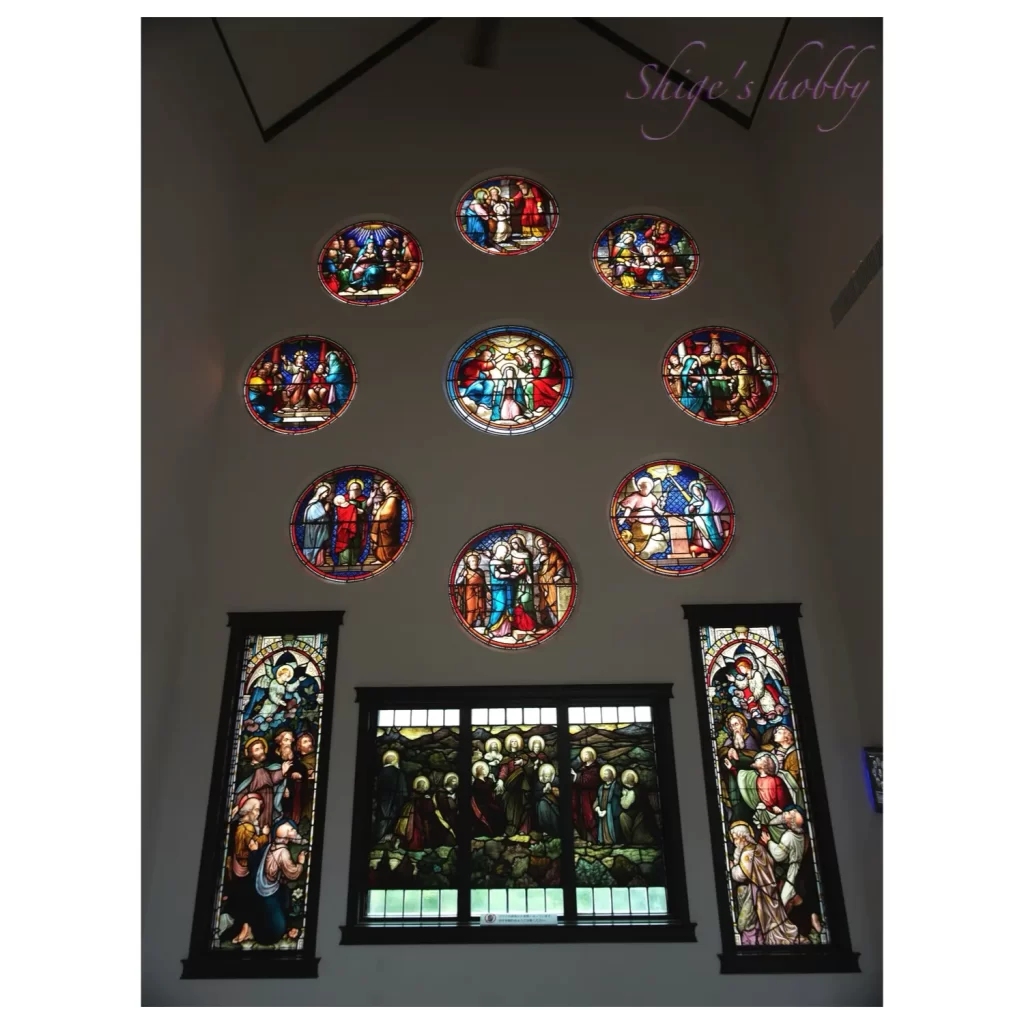
Kakegawa City Ninomaru Museum of Art
- This is my first visit to this art museum that opened in 1998 near Kakegawa Castle.
- Photography is prohibited in the exhibition rooms.
- The World of Woodblock Prints by Makino Munenori
- May 18th (Sat) – July 15th (Mon, Holiday)
- First half of the exhibition: May 18th (Sat) – June 16th (Sun)
- Second half of the exhibition: June 19th (Wed) – July 15th (Mon, Holiday)
- The trouble with printmakers is the problem of the original plate. This artist seems to have chosen to take some of his works apart and reconstruct them. It’s interesting to see how each artist has their own way of doing things.
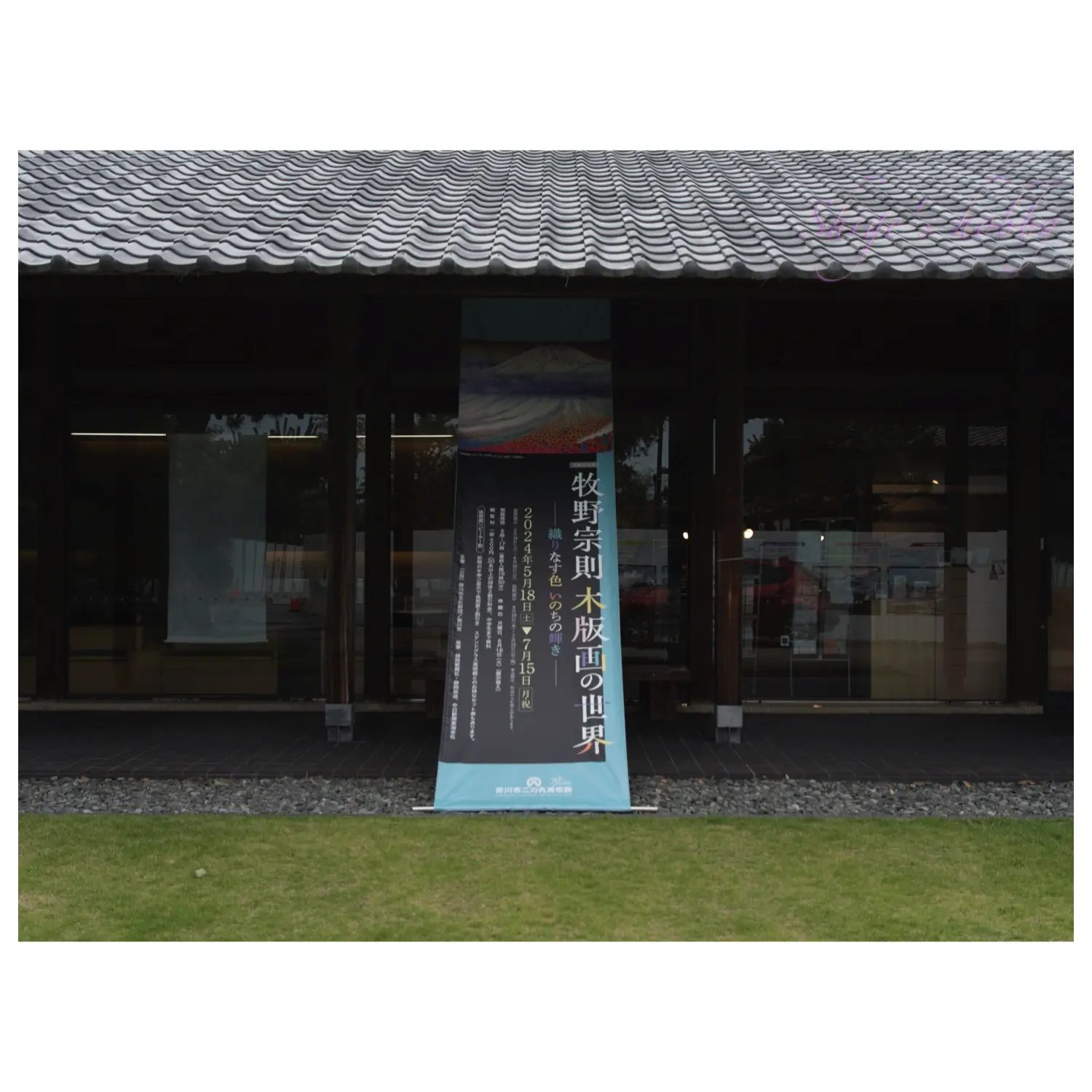
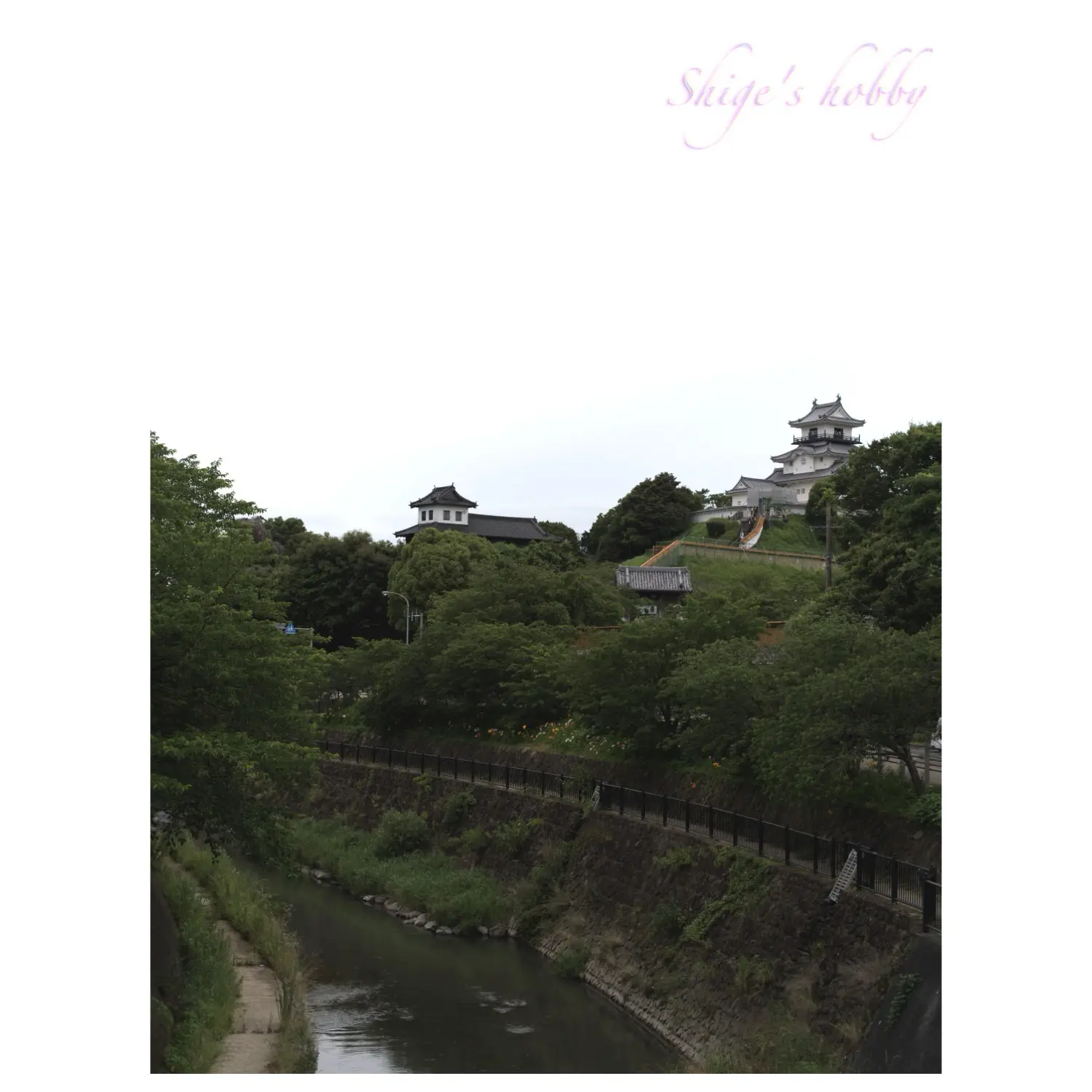
Move to Museum
This time, I was free in the morning, so I got up after 5 o’clock, went to Yokohama Station, and took a local train to Kakegawa. It was a long journey of 3 and a half hours. The Tokaido Line used to have trains that ran to Shizuoka, but now the longest it goes is to Numazu. The 6:20 train stops at Odawara, but the 6:06 train to Numazu is waiting at Odawara Station. Because of this, the 6:06 train seems to stop at Odawara Station for nearly 10 minutes. I bought a green ticket for the Tokaido Line to eat breakfast, but if I buy a green ticket to Numazu, I can use it even if I change trains, so I wish I had bought one this time. I never expected that the train waiting at Odawara Station would have a green car. The JR timetable is quite confusing. It takes 3.5 hours from Yokohama to Kakegawa and costs 3,740 yen, while if you take the Shinkansen, it takes 1 hour and 20 minutes from Shin-Yokohama to Kakegawa and costs 7,140 yen, of which 3,400 yen is for the express fare, so you can save about 2 hours.
I took the Shinkansen on the way back, but I think it’s better to use the Shinkansen considering the balance between fatigue and time. This time, I took it because I had time and wanted to enjoy the view from the Tokaido Main Line window for the first time in a while, but if you’re traveling from the Tokyo metropolitan area to Shizuoka or Hamamatsu, the Shinkansen is the only choice.
Mount Fuji can be seen from Odawara to the Fuji River on the right side of the train, but the train is running at a low altitude and is blocked by buildings, so I had the impression that there were few places where you could see it well. The Shinkansen passes over that area in about 10 minutes, so it’s easy to take a video and cut out your favorite spots.
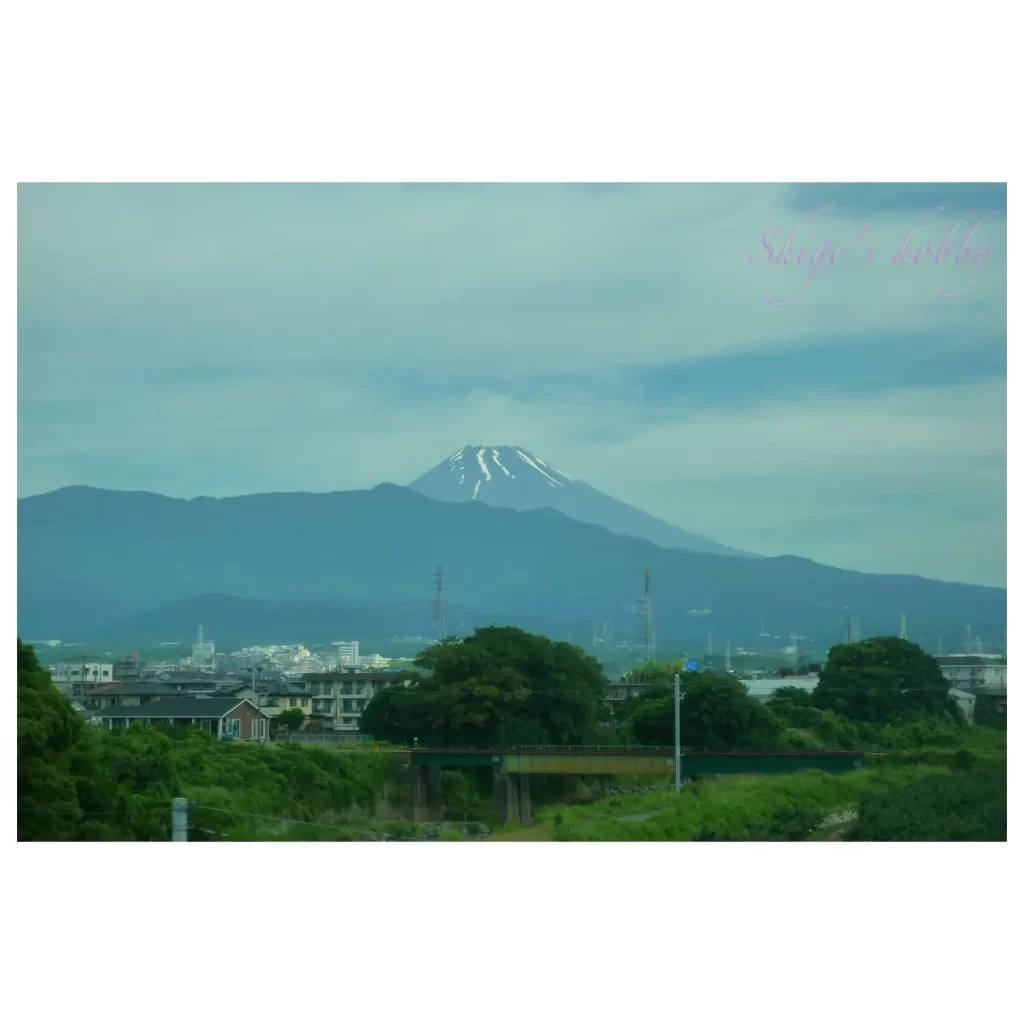
The Tokaido Line has fewer cars as you go west: 15 cars from Yokohama, 10 from Odawara, 6 cars from Numazu (Gotemba Line), and 3 cars from Shizuoka, so the train seemed to be much more crowded.
Change to the Tenhama Line at Kakegawa Station. The fare between Kakegawa and Tenryu-Futamata Station is 710 yen, and the round trip is 1420 yen.
Discount tickets for the Tenhama Line are quite complicated, so the following three are my options. The value depends on how much you use the line during your stay, but the Tenhama Line/Entetsu Common Free Ticket (East Route) for 1600 yen seems to be the best value if you’re just going to the museum.
- Tenhama Line/Entetsu Common Free Ticket (East Route) 1600 yen (discount ticket for Akino Fuku Art Museum)
- One-day pass 1950 yen (discount ticket for Akino Fuku Art Museum)
- Chabatake Ticket (Kakegawa-Nishikashima 1-day free ticket) 1550 yen (no facility discount)
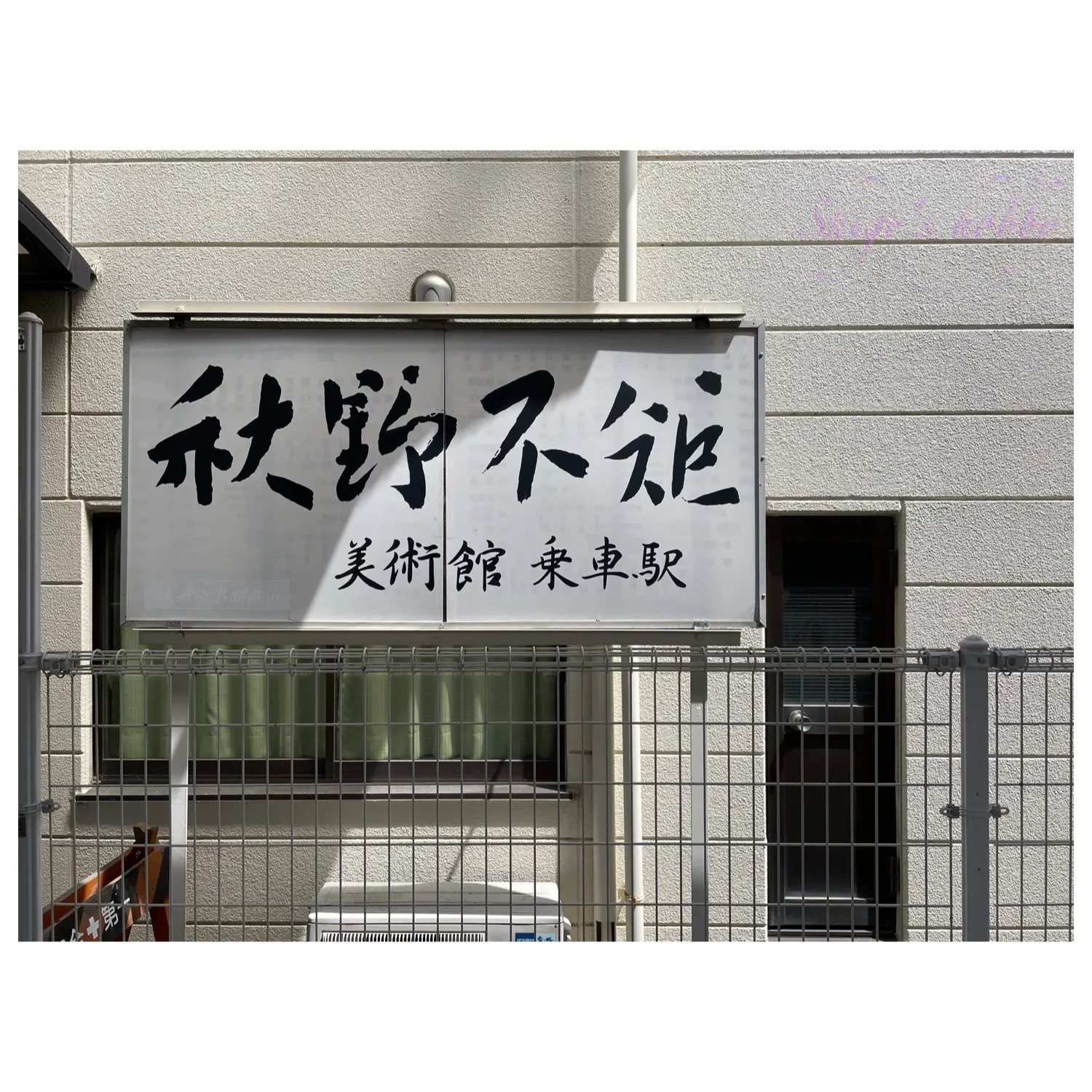
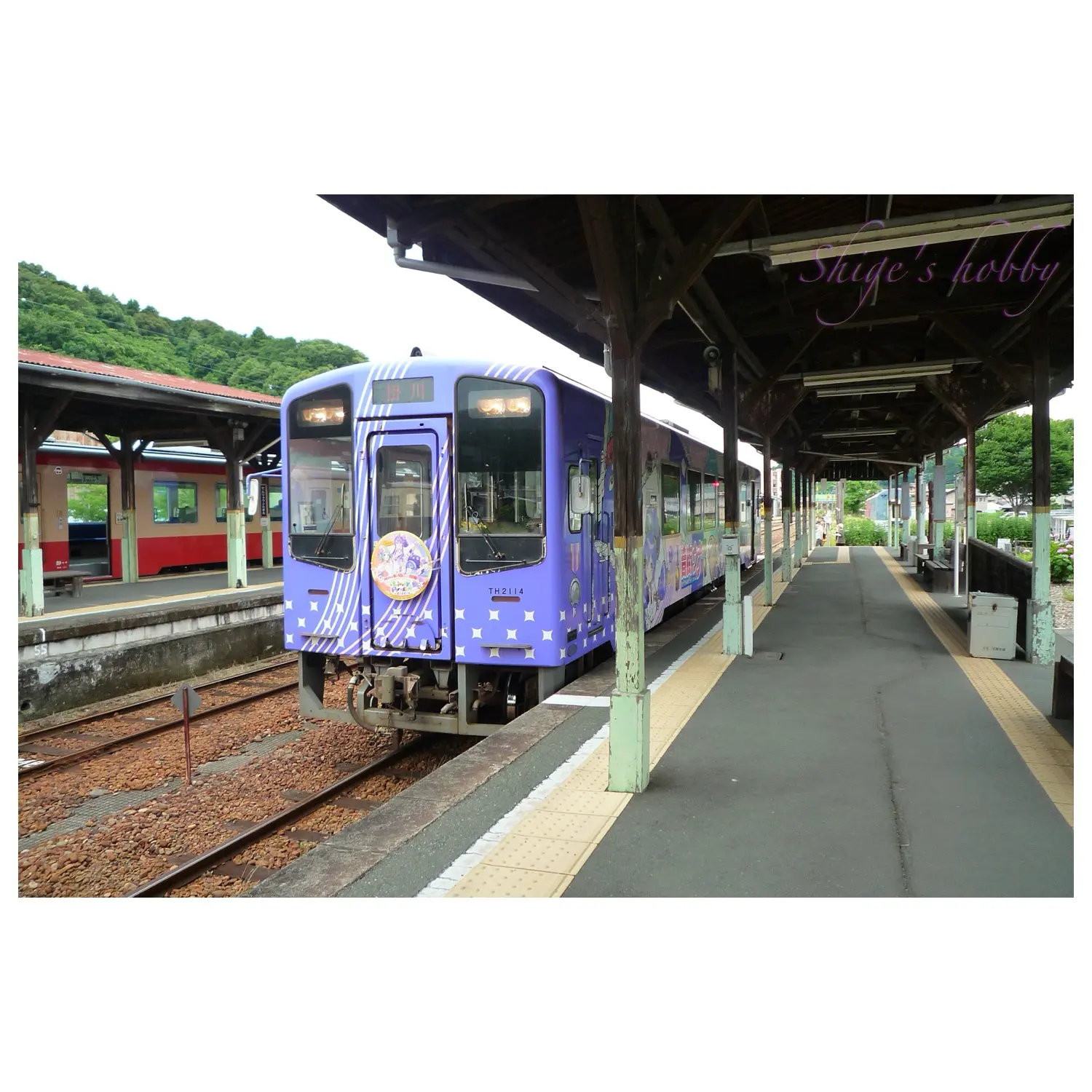
I arrived at Tenryufutamata Station. The attendant recommended that I tour the depot from 10:50, when the motorcycle would arrive, but I prioritized the museum and walked there. It was quite a distance from the station to the museum, and there was a slope at the end, which was tiring.
Also, there were no places to eat inside or around the museum, so you need to be careful about what you eat if you walk. This time, I bought a bento box at the JA near the museum and had lunch in the museum’s outdoor rest area. On the way to the museum, I found a cat. It seemed to be quite old, and was relaxing with an elderly neighbor.
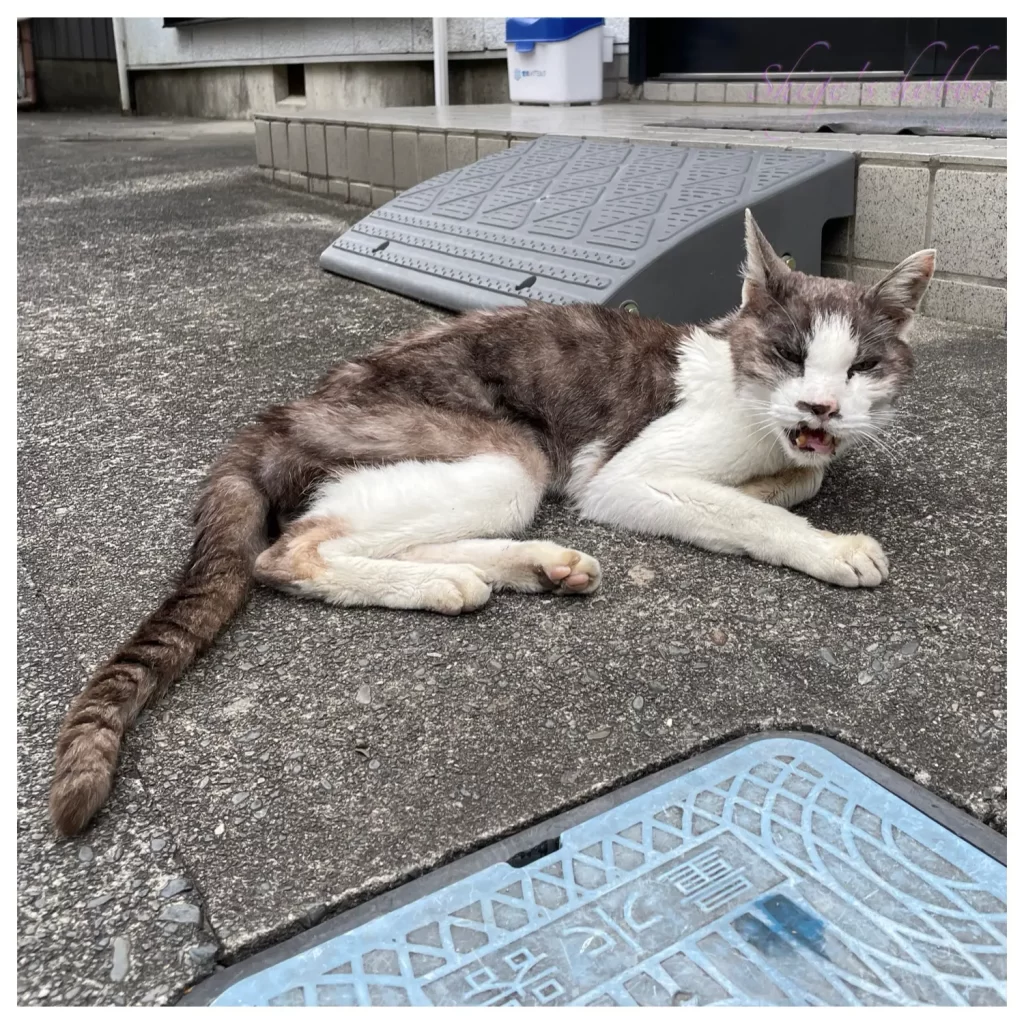
I left the museum at 1pm, returned to Tenryufutamata Station, and took part in a tour of the railcar depot. Since I was still at the station, I got on a motorcycle to Kakegawa.
After wandering around Kakegawa Station for about an hour, I decided to eat some eel, so I went to an eel restaurant I used to go to a long time ago, but after the COVID-19 pandemic, it had become a reservation-only restaurant. I didn’t feel like eating anywhere else, so I got on the Shinkansen. I bought an ekiben at Mishima Station for dinner, and returned to Shin-Yokohama.
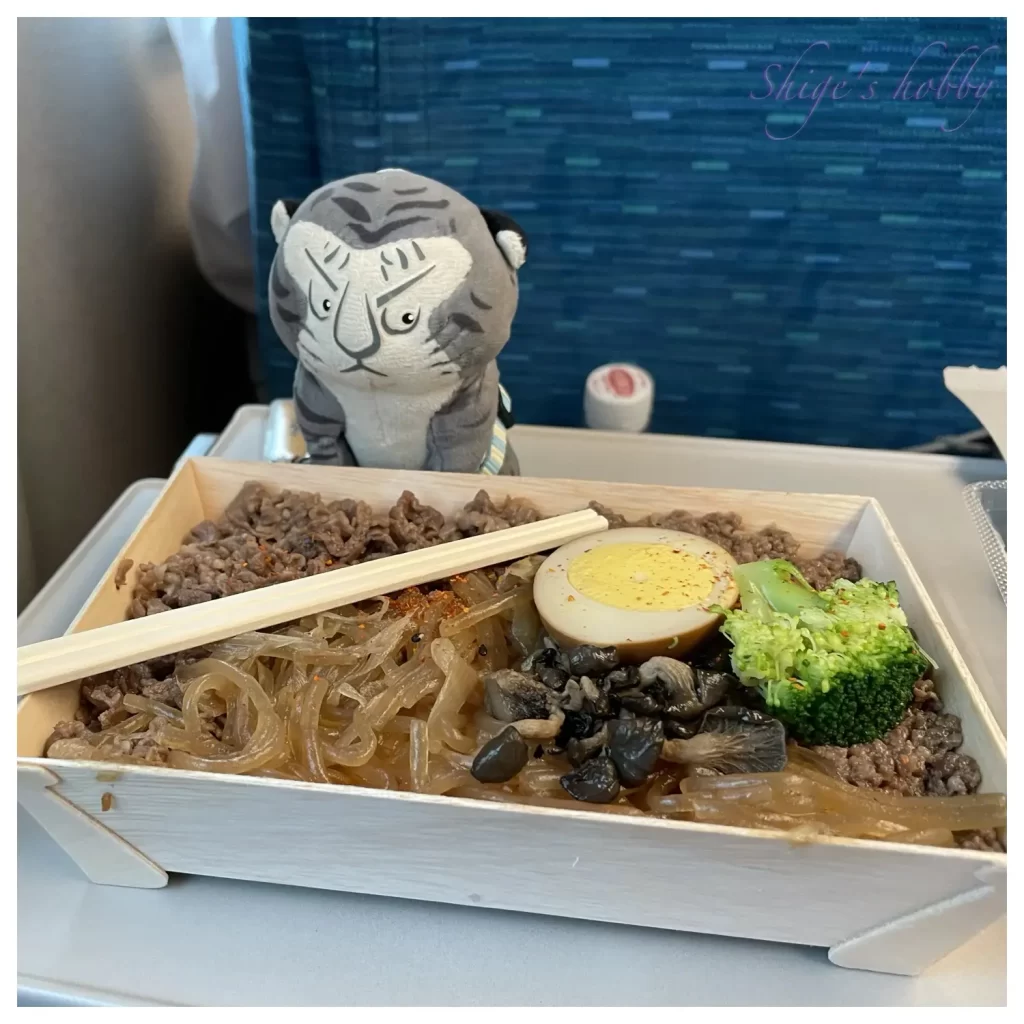
While I was taking a photo of Mt. Fuji on the Shinkansen, a foreigner sitting next to me showed me a photo of him playing golf with Mt. Fuji in the background and said, “I’m going back to the US today after playing golf at the Sanko Golf Club Fuji Course in Oyama Town.” I was impressed that golf is also popular among inbound tourists. There is a demand for courses with a view of Mt. Fuji.
- Yokohama Station 06:20 departure → 09:51 arrival Kakegawa Station (3740 yen)
- Kakegawa Station 09:59 departure → 10:46 arrival Tenryufutamata Station (710 yen)
- Walk from Tenryufutamata Station to the museum (about 15 minutes)
- View “Uchida Aguri Han Fluxes” (800 yen)
- 13:20 Return to Tenryufutamata Station
- 13:50 Visit to the train depot (600 yen)
- 14:30 Train depot visit/end
- Tenryufutamata Station 14:50 departure → 15:38 arrival Kakegawa Station (710 yen)
- Stained Glass Museum about 30 minutes (500 yen)
- Kakegawa City Ninomaru Museum of Art about 30 minutes (500 yen → 400 yen, 2 museum discount)
- Kakegawa Station Departs 17:38 → Arrives 18:59 Shin-Yokohama Station (7,140 yen)
- Meals 2,500 yen (lunch, dinner)
Reference links
Notes
- This was done on June 15, 2024, and the information may change due to changes in road conditions or facility availability, so please check the latest information. Also, when traveling, you can either plan your trip or just go with the flow, so please make your own judgments. I hope this information will be of some use to you.
- About advertisement
- This content contains Google Adsense advertisements and the following Amazon affiliate links, but please note that purchases made through this content will help cover the costs of my activities.
- Fuku Akino・Amazon Affiliate Link
- Aguri Uchida Amazon Affiliate Link
- Photo equipment
- HASSELBLAD X2D +HCD 35-90mm +XH-Converter x0.8
- HEXAR RF LIMITED +KODAK EKTAR 100・36枚
- LEICA C-LUX3
- iPhone 12 mini
- If you have any questions, please contact us using the inquiry form below or by email.
[contact-form-7 id=”e9f144b” title=”Contact form(EN)”]

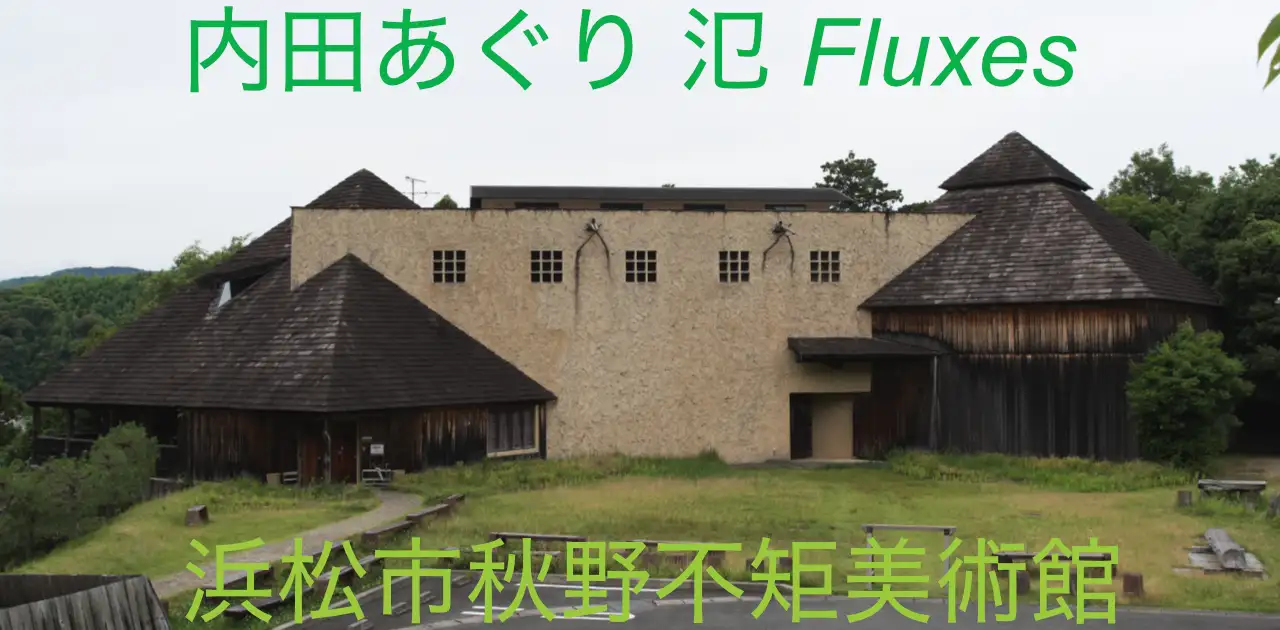
Be First to Comment